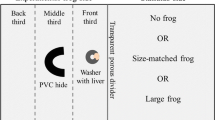Summary
The feeding behaviour of R. dispar was examined with respect to the proportion of prey contents used, the time between successive captures (intercatch interval) and the feeding time. The feeding process consisted of three stages. (1) Injection of venom, (2) breakdown of tissue/digestive stage and (3) extraction of food. The rate of extraction from an individual prey decreases as its contents are depleted, but was shown to increase significantly during the first 15 min before decreasing. Even after 30 min the extraction rate was still marginally higher than the initial extraction rate. This phenomenon is quite different to what has previously been reported for sucking bugs.
There was a negative relationship between increasing prey density and prey depletion, with the predators being significantly more ‘wasteful’, (i.e. prey were discarded before all extractable food was removed) at the two higher prey densities compared with those at the lower densities. As the prey density decreased from 60 to 1 prey per container, so the resultant intercatch interval, feeding time, and the average dry weight extracted per prey increased. No correlation was found between individual intercatch interval and subsequent feeding time when examined throughout a sequence of eight captures. This is taken to support the optimal feeding model in which the predator reacts to the average profitability of the environment (i.e. mean intercatch interval) rather than as reflected by the amount of food in the gut. The effect of the changing rate of extraction of food during a meal allows Ranatra, when exposed to high prey density, to feed for less than half the time on each prey item that it spends at low densities, and yet still obtain 60% of available food.
Similar content being viewed by others
References
Bailey PCE (1984) The feeding behaviour of a sit-and-wait predator — Ethological studies on Ranatra dispar (Heteroptera: Nepidae), the Water Stick Insect. Unpublished Ph.D thesis, University of Adelaide
Bailey PCE (1985a) The feeding behaviour of a sit-and-wait predator, Ranatra dispar (Heteroptera: Nepidae): Description of behavioural components of prey capture and the effect of food deprivation on predator arousal and capture dynamics. Behaviour (in press)
Bailey PCE (1985b) The feeding behaviour of a sit-and-wait predator, Ranatra dispar (Heteroptera:Nepidae): Combined effect of food deprivation and prey size on the behavioral components of predator arousal and prey capture. Z Tierepsychol (in press)
Bailey PCE (1985c) ‘A prey in the hand’ — multi-prey capture behaviour in a sit-and-wait predator, Ranatra dispar (Heteroptera:Nepidae), the water stick insect. J Ethol (in press)
Bailey PCE (1985d) The movement of water into submerged prey during feeding by Ranatra dispar (Heteroptera:Nepidae), the water stick insect. Hydrobiologia (in press)
Bailey PCE (1985e) The feeding behaviour of a sit-and-wait predator, Ranatra dispar (Heteroptera:Nepidae): The effect of prey density and age-structure on the number of prey eaten. Z Tierepsychol (in press)
Charnov EL (1976) Optimal foraging, the marginal value theorem. Theor Pop Biol 9:129–136
Cook RM, Cockrell BJ (1978) Predator ingestion rate and its bearing on feeding and the theory of optimal diets. J Anim Ecol 47:529–547
Ellis RA, Borden JH (1970) Predation by Notonecta undulata (Heteroptera:Notonectidae) on larvae of the yellow-fever mosquito. Ann Entomol Soc Amer 63:963–973
Fox LR, Murdoch WW (1978) Effects of feeding history on shortterm and long-term functional responses in Notonecta hoffmani. J Anim Ecol 47:945–959
Gelperin A (1971) Regulation of Feeding. Ann Rev Entomol 16:365–378
Giller PS (1980) The control of handling-time and its effects on the foraging strategy of a heteropteran predator, Notonecta. J Anim Ecol 49:699–712
Griffiths D (1980a) The feeding biology of Ant-lion larvae: Prey capture, handling and utilization. J Anim Ecol 49:99–125
Griffiths D (1980b) Foraging costs and relative prey size. Am Nat 116:743–752
Griffiths D (1982) Tests of alternate models of prey consumption by predators, using Ant-lion larvae. J Anim Ecol 51:363–374
Hennig E (1968) Über Beziehungen zwischen dem “Probieren” der schwarzen Bohreublattlaus (Aphis fabae Cop.) und dem Stofftransport bei Vicia faba L. Arch Pflanzenschutz 4:75–76
Hodges CM (1981) Optimal foraging in bumblebees: hunting by expectation. Anim Behav 29:1166–1171
Hodges CM, Wolf LL (1981) Optimal foraging in bumblebees: why is nectar left behind in flowers? Behav Ecol Sociobiol 9:41–44
Johnson DM, Akre BG, Crowley P (1975) Modelling arthropod predation: wasteful killing by damselfly naiads. Ecology 56:1081–1093
Krebs JR (1978) Optimal foraging decision rules for predators. In: Krebs JR, Davis NB (eds) Behavioural Ecology an Evolutionary Approach. Blackwell Scientific Publications, Oxford, pp 23–63
Krebs JR (1979) Foraging strategies and their social significance. In: Marler P, Vanderburgh J (eds) Social Behaviour and Communication, Plenum Press, New York, pp 225–270
Krebs JR, Ryan JC, Charnov EL (1974) Hunting by expectation or optimal foraging? A study of patch use by chicadees. Anim Behav 22:953–964
Kruse KC (1983) Optimal foraging by predaceous diving beetle larvae on Toad Tadpoles. Oecologia (Berlin) 58:383–388
McLean DL, Kinsey MG (1968) Probing behaviour of the pea aphid, Acyrthosiphon pisum II. Comparisons of salivation and ingestion in host and non-host plant leaves. Ann Entomol Soc Amer 61:730–739
Miles PW (1972) The saliva of Hemiptera. Adv Insect Physiol 9:183–255
Parker GA, Smith RA (1976) Animal behaviour as a strategy optimizer: evolution of resource assessment strategies and optimal emigration thresholds. Am Nat 110:1055–1076
Pollard DG (1973) Plant penetration by feeding aphids (Hemiptera:Aphidoedea): A review. Bull Ent Res 62:631–714
Pyke GH, Pulliam HR, Charnov EL (1977) Optimal foraging: A selective review of theory and tests. Q Rev Biol 52:137–154
Schoener TW (1971) Theory of feeding strategies. Ann Rev Ecol Syst 11:369–404
Sih A (1980) Optimal foraging: partial consumption of prey. Am Nat 116:282–290
Waage JK (1979) Foraging for patchily distributed hosts by parasitoid, Nemeutis canesceus. J Anim Ecol 48:353–371
Zettler FW (1967) A comparison of species of Aphididae with species of three other aphid families regarding virus transmission and probe behaviour. Phytopathology 57:398–400
Author information
Authors and Affiliations
Rights and permissions
About this article
Cite this article
Bailey, P.C.E. The feeding behaviour of a sit-and wait-predator, Ranatra dispar (Heteroptera: Nepidae): optimal foraging and feeding dynamics. Oecologia 68, 291–297 (1986). https://doi.org/10.1007/BF00384802
Received:
Issue Date:
DOI: https://doi.org/10.1007/BF00384802




